
Harmonia axyridis is a large lady beetle or ladybug species that is most commonly known as the harlequin, Asian, or multicoloured Asian lady beetle. This is one of the most variable species in the world, with an exceptionally wide range of colour forms. It is native to eastern Asia, but has been artificially introduced to North America and Europe to control aphids and scale insects. It is now common, well known, and spreading in those regions, and has also established in Africa and widely across South America. This species is conspicuous in North America, where it may locally be known as the Halloween beetle, as it often invades homes during October to overwinter.

The Anthicidae are a family of beetles that resemble ants. They are sometimes called ant-like flower beetles or ant-like beetles. The family comprises over 3,500 species in about 100 genera.

The noble chafer is a species of beetles belonging to the family Scarabaeidae, subfamily Cetoniinae.

African dwarf frog is the common name for members of Hymenochirus, a genus of aquatic frog native to parts of Equatorial Africa. They are common in the pet trade and are often mistaken for the African clawed frog, a similar-looking frog in the same family. Their common name is obtained from their place of origin and the claws on their hind legs.
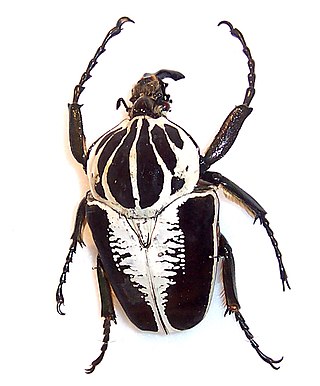
The Goliath beetles are any of the five species in the genus Goliathus. Goliath beetles are among the largest insects on Earth, if measured in terms of size, bulk and weight. They are members of subfamily Cetoniinae, within the family Scarabaeidae. Goliath beetles can be found in many of Africa's tropical forests, where they feed primarily on tree sap and fruit. Little appears to be known of the larval cycle in the wild, but in captivity, Goliathus beetles have been successfully reared from egg to adult using protein-rich foods such as commercial cat and dog food. Goliath beetles measure from 60–110 millimetres (2.4–4.3 in) for males and 50–80 millimetres (2.0–3.1 in) for females, as adults, and can reach weights of up to 80–100 grams (2.8–3.5 oz) in the larval stage, though the adults are only about half this weight. The females range from a dark chestnut brown to silky white, but the males are normally brown/white/black or black/white.
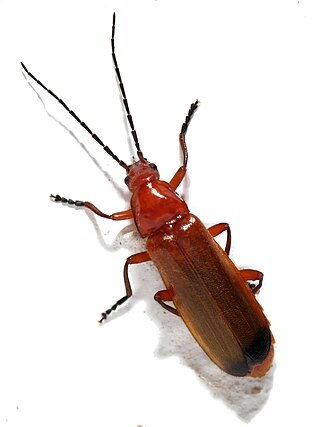
Rhagonycha fulva, the common red soldier beetle, also misleadingly known as the bloodsucker beetle, and popularly known in England as the hogweed bonking beetle is a species of soldier beetle (Cantharidae).

Actaeon beetle is a rhinoceros beetle of the family Scarabaeidae.
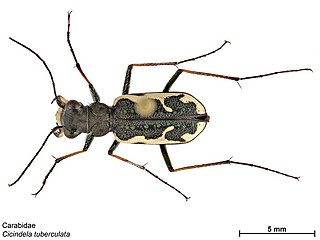
Neocicindela tuberculata is a species of tiger beetle in the family Cicindelidae, endemic to New Zealand. Its common names include common tiger beetle, moeone, and papapa, and in its laval stage penny doctor, butcher boy, kapuku, kui, kurikuri, moeone, and muremure. Neocicindela tuberculata was the first carabid beetle described from New Zealand. The species can run as fast as 5 miles per hour and are considered to be the fastest running beetles. Adult species prefer clay banks in summer and are good predators when in comes to insects.

Athous haemorrhoidalis is a species of European and Asian click beetles in the genus Athous. Several variations are recognized.

Coccinellidae is a widespread family of small beetles. They are commonly known as ladybugs in North America and ladybirds in the United Kingdom; "lady" refers to mother Mary. Entomologists use the names ladybird beetles or lady beetles to avoid confusion with true bugs. The more than 6,000 described species have a global distribution and are found in a variety of habitats. They are oval beetles with a domed back and flat underside. Many of the species have conspicuous aposematic (warning) colours and patterns, such as red with black spots, that warn potential predators that they taste bad.

Tenebroides mauritanicus, commonly known as the cadelle, is a species of beetle in the family Trogossitidae. It is a common cosmopolitan pest in storehouses and granaries.

Pachyta quadrimaculata is a species of the Lepturinae subfamily in long-horned beetle family.

Agriotes sputator is a species of click beetle, commonly known as the common click beetle. The adult beetle is brown and inconspicuous, and the larvae live in the soil and are known as wireworms. They are agricultural pests that devour the roots and underground parts of many crops and other plants.

The milkweed leaf beetle is a species of leaf beetle from the family Chrysomelidae. It is round bodied, 8–11 mm in length with a black head and pronotum and bright orange to yellow elytra with variable mottled black patches. Its colored and shaped like a super-sized ladybird beetle even though the ladybird is in a different family, Coccinellidae. The larva is shaped much like the adult except with a small tail extension. Its color varies from bright orange to white with a gray to black pronotum and prominent black spots around its spiracles.

Aphidecta obliterata is a species of Coccinellidae, a flying beetle.
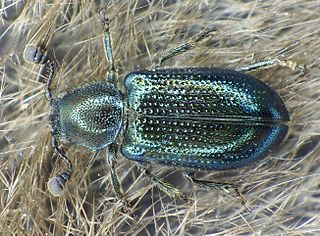
Necrobia violacea is a species of beetle in family Cleridae. Cleridae beetles are a predaceous beetle found within forest and woodland environments, and can be associated with stored food products as both pests and predators of other insects.

Tillus elongatus is a species of beetle in the family of checkered beetles Cleridae. It is found in the Palearctic. The “Holz” in the German common name Holzbuntkäfer indicates that these checkered beetles are found in wood. Although Tillus elongatus can reach up to a size of 1 cm long, the beetle is rarely seen by humans, as it primarily resides hidden in the wood of trees. The colouration of the males differs from that of the females.
Bucolus fourneti is a native Australian, small, hairy coccinellid beetle approximately 2.1-4.5 mm in diameter. It was described by Étienne Mulsant in 1850
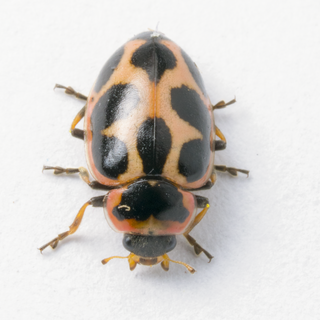
Naemia seriata, commonly known as the seaside lady beetle, is a large coccinellid beetle native to North America, and the only species in the genus Naemia. It is found in coastal areas such as beaches, salt marshes, and bay islands on the Atlantic and Pacific coast. This beetle is light brown, yellow, orange, or red in color, with large black spots, often connected along the sides. The pronotum usually has one large central black spot, which is occasionally split into two spots. The body of this species is elongately oval in shape, and between 4 and 6.7mm in length. The two subspecies can be distinguished by markings on the head, with the head of N. seriata seriata being black, while the head of N. seriata litigiosa has a pale triangular marking. Naemia seriata seriata is primarily distributed across Eastern North America, while N. seriata litigiosa is restricted to the American Southwest.
Melasis fermini is a rare species of soldier beetles native to a small area of Spain. It has only been found in three locations in Guadalajara, Caceres, and Ciudad Real, and its estimated range is less than twelve square kilometers. The species was named in honor of the late Fermín Martín Piera, a Spanish biologist and taxonomist who specialized in the study of dung beetles.

















